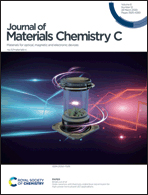Liquid crystal ionic self-assembly and anion-selective photoluminescence in discotic azatriphenylenes†
Abstract
We report on the straightforward synthesis of a new series of ionic discotic liquid crystals based on positively charged azatriphenylene. In our design, the quaternized azatriphenylene core is surrounded by four to six flexible aliphatic chains and various types of anions, including small inorganic anions (i.e. Br−, I−, NO3−, BF4−, PF6−), and organic ones such as triflate, bis(trifluoromethylsulfonyl)imide, tosylate, saccharinate, D and L camphorsulfate, alkylsulfonates, and alkylsulfates. The mesophases and thermal behaviour of the salts were characterized by polarizing optical microscopy, differential scanning calorimetry, thermal gravimetry and small-angle X-ray scattering. A classical hexagonal columnar mesophase, i.e. p6mm-Colhex, was observed for most salts. Two exotic new phases were however identified for four compounds, namely a mesophase with a hexagonal lattice of p3m1 symmetry (Hex), and another mesophase with a rectangular lattice of pseudo-hexagonal geometry (i.e. a/b = √3) of p2mg symmetry (Recphex). The former results from the bulkiness of the triflimide anion and the arrangement of columns into a honeycomb lattice, whereas the latter is induced by the clustering of three columns, disposed according to a low-symmetry rectangular lattice. Their temperature ranges and stabilities strongly depend as expected on the anion type and the number (and length) of the alkyl side-chains (O- and N-alkyl, respectively), highlighting the delicate balance and interplay between van der Waals, electrostatic and π–π core interactions. The UV/Vis absorption and fluorescent emission spectra were measured, and a strong yellow light photoluminescence was observed depending on the anion type, whereas anion-selective luminescence was observed in thin films. The neutral azatriphenylene precursor, 6,7,10,11-tetrakis(hexyloxy)dibenzo[f,h]isoquinoline, is also an interesting luminophore, showing an absolute emission quantum yield of 75%, while the corresponding salts exhibit anion-selective emission quantum yields as high as 20%.



 Please wait while we load your content...
Please wait while we load your content...